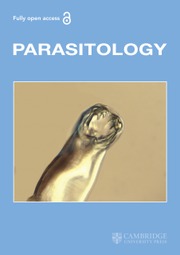Crossref Citations
This article has been cited by the following publications. This list is generated based on data provided by Crossref.
Bishop, Ann
1933.
The Morphology and Division of Hexamita gigas n.sp. (Flagellata).
Parasitology,
Vol. 25,
Issue. 2,
p.
163.
Bishop, Ann
1934.
The Intestinal Protozoa of a Muskrat, Fiber (= Ondatra) zibethica, with a Note upon Retortamonas sp. from the Guinea-pig.
Parasitology,
Vol. 26,
Issue. 4,
p.
578.
Bishop, Ann
1934.
Observations upon Embadomonas intestinalis in Culture.
Parasitology,
Vol. 26,
Issue. 1,
p.
17.
Dobell, Clifford
1935.
Researches on the Intestinal Protozoa of Monkeys and Man.
Parasitology,
Vol. 27,
Issue. 4,
p.
564.
Nie, Dashu
1950.
Morphology and taxonomy of the intestinal protozoa of the guinea‐pig, cavia porcella.
Journal of Morphology,
Vol. 86,
Issue. 3,
p.
381.
Reichenbach-Klinke, H.
and
Elkan, E.
1965.
The Principal Diseases of Lower Vertebrates.
p.
220.
Warhurst, David C.
1967.
Cultivationin vitroofEndolimax blattaeLucas, 1927 from the cockroach hind gut.
Parasitology,
Vol. 57,
Issue. 1,
p.
181.
Vetterling, John M.
1976.
The Biology of the Guinea Pig.
p.
163.
Hampl, Vladimir
2016.
Handbook of the Protists.
p.
1.
Hampl, Vladimir
2017.
Handbook of the Protists.
p.
1139.
Treitli, Sebastian C.
Kotyk, Michael
Yubuki, Naoji
Jirounková, Eliška
Vlasáková, Jitka
Smejkalová, Pavla
Šípek, Petr
Čepička, Ivan
and
Hampl, Vladimír
2018.
Molecular and Morphological Diversity of the Oxymonad Genera Monocercomonoides and Blattamonas gen. nov..
Protist,
Vol. 169,
Issue. 5,
p.
744.

